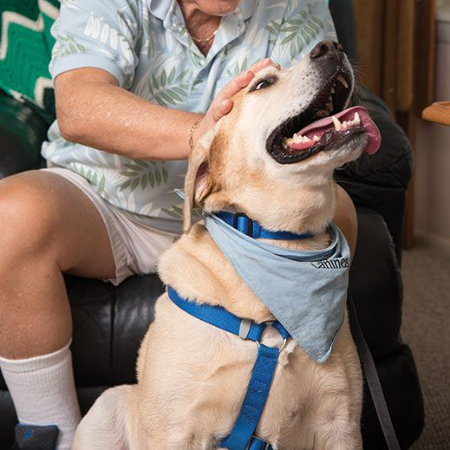“The Role of Dogs in Therapy: How They Help Heal and Comfort Humans”
Given the prevalence of stress, worry, and emotional strain in today’s environment, it is understandable that so many individuals seek solace and healing from non-traditional sources. Dog therapy is one of the most endearing and successful approaches that is becoming more and more popular.
These furry friends have shown to be more than simply adorable pets; they’re emerging as key figures in the therapeutic industry, providing consolation and healing in ways that science is still learning how to completely comprehend.
The Unseen Magic of Canine Companionship
Imagine being greeted by a wagging tail and expressive eyes as you enter a room. Dogs have a profound effect on our mental and emotional health, and that effect goes far beyond the instant happiness and relaxation they provide you.

Dogs, often without uttering a word, have a remarkable ability to make humans feel loved and accepted. Their function in therapy is based on their innate capacity for empathy and love without conditions.
The Science Behind the Snuggles
Science supports the therapeutic advantages of dogs, not simply anecdotal evidence. Studies have indicated that socializing with dogs can result in a drop in cortisol levels, which are linked to stress.
On the other hand, time spent with a dog can cause the production of oxytocin, which is sometimes called the “love hormone” and improves emotions of bonding and trust. Research has indicated that therapy dogs can considerably reduce a person’s heart rate and blood pressure while they are under stress.
Petting a dog can be a simple yet calming activity that helps to ease anxiety and promote calmness. These physiological reactions frequently occur instantly, providing a rapid and efficient means of stress management.
A Tail-Wagging Therapy Team
Therapy dogs are specifically trained to offer people consolation and assistance in a variety of contexts. These environments can include schools, elderly homes, hospitals, or catastrophe areas.
These dogs receive training that guarantees their ability to function in a variety of settings, making them dependable and flexible therapeutic partners. Therapy dogs visit patients in hospitals to provide emotional support and companionship.
Their presence can lighten a patient’s day and help them feel less afraid of the medical setting. Therapy dogs can bring much-needed joy and distraction to kids undergoing medical procedures or extended hospital stays.

Therapy dogs in schools assist kids in managing stress, anxiety, and even academic challenges. They provide a consoling and nonjudgmental presence that helps relieve the stress of social situations and academic obstacles. Therapy dogs can offer exceptional assistance to kids with special needs, improving their capacity to interact and take part in the learning environment.
Healing Through Connection
The extraordinary ability of therapy dogs to establish strong emotional bonds with the individuals they assist is one of their most remarkable qualities. This kind of connection frequently goes beyond words and offers consolation and understanding that can be immensely therapeutic.
The company of a therapy dog can provide people with mental health problems with a feeling of purpose and a method to control their emotions. Therapy dogs can be a lifeline for people who are experiencing trauma.
Their presence can give people a feeling of security and stability and enable them to process their experiences in a non-threatening and helpful setting. Dogs’ unconditional compassion and nonjudgmental disposition can be immensely reassuring to people who feel alone or misinterpreted.
Stories of Transformation
Let’s delve into some real-life examples of how therapy dogs have made a difference in people’s lives:
- Casey the Brave Dog:
Trained to help warriors suffering from post-traumatic stress disorder, Casey is a Labrador Retriever. Many veterans found comfort in his compassionate demeanor and calming presence as they dealt with the day-to-day difficulties of their illness.
Because Casey could detect when his human needed comfort, he was able to offer timely support that gave the human emotional relief as well as a sense of security.
- Bella’s Big Impact:
Every week, Golden Retriever Bella would go to a nearby children’s hospital. Her relationships with the younger patients provide a much-needed diversion from their medical procedures.
Children who might otherwise be stressing over illness and hospital life smiled and laughed at Bella’s fun antics and kind disposition.
- The Part Played by Rex in Recovery:
Rex, a German Shepherd, participated in a program that matched therapy dogs with addicts in recovery. His presence in therapy sessions made patients feel less alone and more rooted.
Rex’s relationship with the participants served as a source of support and encouragement during their difficult road to recovery.
The Future of Canine Therapy
The role that therapy dogs play in a variety of therapeutic settings is expanding along with our awareness of their advantages. Scholars are currently investigating novel approaches to include canine therapy in various domains, ranging from mental health and recovery to teaching and community outreach.

Novel initiatives that blend conventional therapy with interventions aided by canines are beginning to take shape. Through the integration of the special advantages of canine companionship into different treatment approaches, these programmes seek to improve therapeutic outcomes.
We should expect to see increasingly more inventive and successful uses of therapy dogs as science and technology progress.
Embracing the Power of Paws
The role of therapy dogs in healing and comfort is a testament to the incredible bond between humans and animals. Their ability to provide emotional support, reduce stress, and foster healing is a powerful reminder of the positive impact that animals can have on our lives.
As we continue to explore and appreciate the benefits of canine therapy, one thing remains clear: the love and loyalty of a dog can be an invaluable asset in our journey toward healing and well-being.
So, the next time you find yourself in need of a little extra comfort or a dose of joy, remember that the wagging tail and warm eyes of a therapy dog might just be the perfect remedy. These furry healers are more than just pets; they’re partners in the journey to a healthier, happier life.
Doglime for more dog-related information.
Tags










